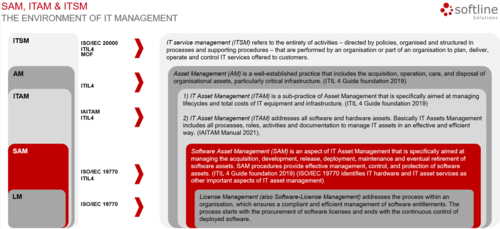IT professionals love their frameworks, terms and abbreviations, and the ITAM crowd is no different.
That wouldn’t be a problem if everybody had the same understanding of the terms used. However, there is a lot of confusion, and interpretations vary depending on the context, the author, and the audience. To help you make sense of it all, we have compiled a list of frequently used terms in our field.
BLOG - April 2021: SAM, ITAM & ITSM: making sense of the frequently used terms in the IT Management environment
IT Service Management (ITSM)
Let’s start with the one most people are familiar with, ITSM: “The entirety of activities – directed by policies, organised and structured in processes and supporting procedures – that are performed by an organisation or part of an organisation to plan, deliver, operate and control IT services offered to customers.”, as described in ITIL.
The benefit of positioning ITAM within the context of ITSM, is not just the use of a common context and language, but also the simple fact that ITAM is heavily reliant on ITSM processes to reach its goals.
Asset Management (AM)
The broad term Asset Management (AM) is defined within the ITIL 4 framework as follows: “…a well-established practice that includes the acquisition, operation, care, and disposal of organisational assets, particularly critical infrastructure.” This definition sets the stage for describing increasingly more specific terms.
IT Asset Management (ITAM)
We can view IT Asset Management (ITAM) as a specific form of Asset Management, a sub-set if you will. There are quite a few definitions around; for the purpose of this publication we want to highlight two that are complementary:
- ITIL 4 defines ITAM as “a sub-practice of Asset Management that is specifically aimed at managing lifecycles and total costs of IT equipment and infrastructure.”
- The IAITAM Manual 2021 has a slightly different approach: “IT Asset Management addresses all software and hardware assets. Basically, IT Asset Management includes all processes, roles, activities, and documentation to manage IT assets in an effective and efficient way”.
The two definitions combine some very important points to keep in mind:
- Manage assets throughout their lifecycles.
- Don’t forget to include your infrastructure components.
- Hardware and software are both parts of ITAM: you will have to manage both together to be successful in your ITAM program.
- Processes, roles activities, and documentation are vital parts of ITAM.
Software Asset Management (SAM)
Software Asset Management is an even more specific aspect of ITAM, defined within ITIL 4 as “an aspect of IT asset management that is specifically aimed at managing the acquisition, development, release, deployment, maintenance and eventual retirement of software assets. SAM procedures provide effective management, control, and protection of software assets.”
Since the 2017 version, the ISO/IEC 19770 standard identifies two other major aspects of ITAM besides SAM: IT hardware and IT asset services (XaaS). Both aspects have been around and in use before the standard was developed, and in practice, they were already an important part of the daily routine of ITAM professionals. With the newest ISO version, they are explicitly given the same status as software within the framework.
License Management (LM or Software License Management)
License Management (also Software License Management) “addresses the process within an organisation, which ensures compliant and efficient management of software entitlements. The process starts with the procurement of software licenses and ends with the continuous control of deployed software.”
Please note: this is about the management of licenses over the entire lifecycle!

